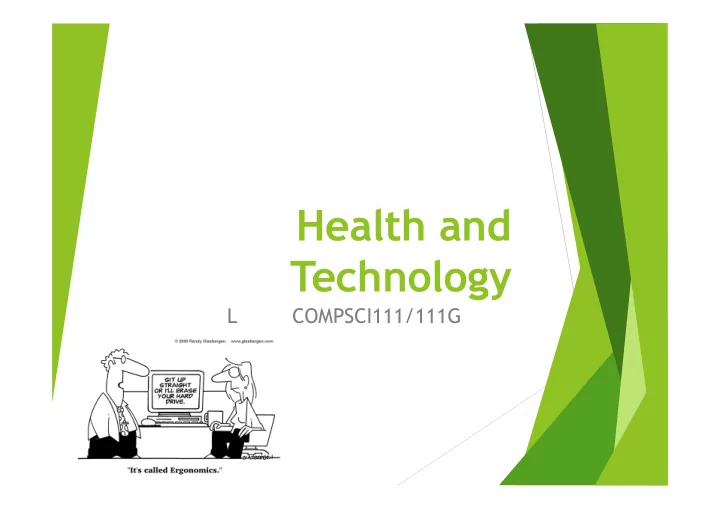

Health and Technology L COMPSCI111/111G
Health and Technology u T echnology has a large impact on our lives, not all of it positive. u We will discuss the following types of health issues related to technology: u Psychological u Physical
Psychological Issues iDisorders
Distraction u Digital devices are highly pervasive and are demanding of our attention. u “Cognitively penetrating” u Checking – repeatedly accessing your digital device interrupting your current activity . u A 2012 study of 777 students at 6 U.S. universities found that : u On average a student used a digital device for non- class purposes 11 times during a typical school day . u 80% indicated that such behaviour caused them to pay less attention in class and miss instruction.
Instant Gratification u The desire to experience pleasure or fulfilment without delay or deferment. u Y ou want it, and you want it now . u Always online digital devices have raised the expectation for immediate gratification. u E.g. expecting immediate responses to social media posts or texts. u Has resulted in: u Increased impatience u Unrealistic expectations u “checking”
Narcissism u Personality trait characterized by a grandiose sense of self-importance. u Engage in self-promotion, vanity and superficial relationships. u Y ounger people show a stronger urge to report their activities and believe their social media audience care about them. u A 2009 study of 16000 college students in the US found that they scored substantially higher on the Narcissism Personality Inventory than their cohort 20 years ago. u Studies have suggested social media exacerbates and even encourages narcissism. u Users may tailor their profile pictures, status updates, biographies and even lists of friends in order to appear more attractive.
Mood Disorders u Extensive evidence documenting a relationship between depression and technology . u Excessive texting, viewing video clips, video gaming, chatting etc. u Depression may be transmittable through technological interaction. u Consumption of depressing media, particularly movies and music can induce a negative affect. u “emotional contagion”
Deficits in Social Skills u Increased interaction with technology has led to a reduction in human interaction. u Face-to-face communication skills are negatively affected. u Visual cues are an important part of face-to-face communication. u Includes facial expression, eye contact, tone of voice, posture, and spatial distance. u Need to be able to modify one’s own behaviour in response to the reactions of others. u A 2014 study of 105 U.S. children was carried out. u 51 children in the test group did not use digital devices for 5 days – only face-to-face communication. u 54 children in the control group continued to use their digital devices. u T est group recognition of nonverbal emotional cues was significantly better than that of the control group.
Physical Issues
Computer Vision Syndrome u Results from focusing eyes on a computer or other display device for long, uninterrupted periods of time. u Symptoms of CVS include: u Dry eyes u Blurred/double vision u Eyestrain u Red/irritated eyes u T reatment/Prevention: u Proper lighting within computer workstation area u Appropriated screen distance and position u Work breaks u Lubricating eye drops
Hearing Loss u Listening to media through headphones or earbuds for prolonged periods of time at high volume can cause permanent hearing loss. u A 2005–2006 study reported that 19.5% of American adolescents aged 12 to 19 suffered from hearing loss. u An increase of 33% from that reported in 1988–1994. u Some of this increase may be attributable to headphone/earbud usage. u Prevention: u Lower volume. If other people can hear the music you are listening to it is most probably too loud. u Limit exposure. Moderate noise on a regular basis can lead to hearing loss.
Occupational Overuse Syndrome u Also referred to as Repetitive Strain Injury (RSI). u Umbrella term for range of conditions characterized by: u Muscle discomfort u Aches and pains u Muscle tightness and spasms u Numbness and tingling u Pain may eventually become constant and associated with loss of muscle strength and sleep disturbances. u Factors that can lead to OOS developing include: u Repetitive movement – e.g. typing u Awkward postures – e.g. sitting at a desk u Poor ergonomics u Psychosocial factors – excessive workload, impending deadlines u Poor work practices - e.g. poor time management
Occupational Overuse Syndrome u There are a number of steps that can be taken to prevent OOS. u From a workplace perspective: u Design equipment and tasks with people in mind e.g. ergonomic workstations. u Pay attention to work environment – e.g. lighting. u T rain and educate all staff. u From a personal perspective: u Stop activity when discomfort is felt u Maintain correct posture u T ake regular breaks u Avoid prolonged, repetitive movement or activity u Manage stress levels u Educate yourself about OOS prevention
General Solutions for Healthy Use of T echnology u T ake breaks both large and small. u Moderate your social media presence. u T ry cutting down the number of posts or status updates you make each day . u Are you posting for narcissistic reasons or with communication as a goal? u Give your work or entertainment space an ergonomic makeover . u Pay attention to lighting, chair , display position etc. u Maintain a healthy lifestyle. u Appropriate diet u Exercise u No smoking
Summary u T echnology can have a negative effect on your health. u Psychological Issues: u Distraction u Instant gratification u Narcissism u Mood disorders u Deficits in social skills u Physical issues u Computer Vision Syndrome (CVS) u Hearing loss u Occupational Overuse Syndrome (OOS)
Recommend
More recommend